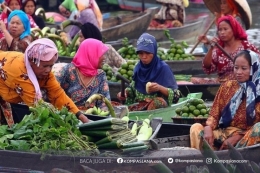First, the nation state becomes a direct result of modern character which has a spirit of universalization. Anderson understands the process of the emergence of this nation-state is inspired by the context and global realities that have existed before. If, in the initial context of globalization the pattern of interaction occurs in the local sphere that transforms through its various encounters with new identities, then the birth of the State is something that is considered imagined. Here, Anderson mentions new interests to realize territorial boundaries which are called nations "imagined political community - and imagined as both inherently limited and sovereign" (2006, 6). The attention of power is no longer trying to create new powers where there is a system of centralized power that is global, but the main concern is precisely bound to the limit of national spirit where people begin to define themselves based on ancestry, religion, language, history value, customs, and institution (Huntington, 1996).
Furthermore, global interactions in the period that followed the birth of this nation state were "In the post-Cold War world, for the first time in history, global politics has become multipolar and multicivilizational" (Huntington, 1996, 21). In this case, an important distinction in human interaction is about culture. Huntington calls this period a new form of world conflict but is concentrated on the struggle between civilizations and ethnicities. Here, the position of religion as part of political identity becomes significant. Huntington's thesis attempts to explain that there has been a new civilization conflict caused by religious differences as happened in various parts of the world. However, this thesis on the clash of civilization is unable to explain that in some regions and nations precisely the conflict between civilizations does not occur significantly.
Continuing the point that Anderson has explained about Imagined community, the period of technological civilization has shaped virtual global interactions (Lim 2012, 128; Vasquez and Marquardt 2003, 48). If in Anderson's imagination, that the spirit of forming the nation is influenced by the availability of material such as the media, the technology that enables communication, then Lim further mentions the deeper form of communication in the form of a phase to face reality. Lim mentioned in this case that "the Internet is assumed to allow community is also commonly extended to other forms of communities, such as ethnic, regional, and religious communities such as ummah" (2012, 137). However, interestingly is that when the internet allows it to occur "the rapid flow of information, images and ideas" (137),.. "There are significant differences and tensions across nation-states and cultures despite shared religious identities (138).
The explanation above has provided an important picture to understand the process of globalization as a continuation of the dynamics that have been running throughout the history of mankind. The division of history into two phases, namely the early centuries before the modern and the post-modern century became a significant momentum in seeing the dialectics of the history of globalization. In the early historical moments, before the modern century (1400 CE), understanding the process of globalization was about the dynamics and processes of global interaction that demanded a historical process that reproduced and contested in a certain time and space. Some of the dominant patterns include imagery through trading in various parts of the continent. This then has an impact on the process of transfer of knowledge and early civilization. Religion has colored each of these processes and dynamics as the initial phase under empire control and centralized power. Meanwhile, in the post-modern period, which is after 1400, there was a peak of massive global interaction. The momentum of history at this time is marked by the emergence of new spaces of rapid interaction through technological developments. At this moment, the social interaction system began to touch civilizations that were difficult to reach like indigenous communities. Various practices of belief and tradition are almost certainly touched by the outside world.
In this case, Anderson confirmed that "Globalization is not just about the flows of ideas, goods, people, and capital but also about the practices and organizational structures of territorialized actors like migrants, the state, and churches (Anderson 2006, 6). If the effort to understand globalization cannot be separated from the local context and patterns of interaction that are very unique and different from one another, then there is no interest in understanding globalization as something new or not. Such efforts are tantamount to understanding the emergence of ideas as transhistorical. In fact, understanding social change and the various patterns of interaction within it cannot be separated from the historical context and actors in the power relations that shape it. The consequence of this, furthermore, is that a unique variety of variations in human history will not necessarily reduce the complexities or attempt to see it uniformly. But in every single element of it, there is diversity and uniqueness of the results of the articulation and dialectics across human civilizations.
BIBLIOGRAPHIES
Anderson, Benedict. 2006. Imagined Communities: Reflections on the Origin and Spread of Nationalism. Nationalism. London and New York: Verso.
Huntington, Samuel P. 1996. The Clash of Civilization and the Remarking of World Order.
Lim, Merlyna. 2012. "Life Is Local in the Imagined Global Community: Islam and Politics in the Indonesian Blogosphere." Journal of Media and Religion 11 (3): 127--40.
Sen, Amartya. 2002. "How to Judge Globalism." The American Prospect 13 (1): A2--6.








